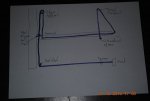ylop
Well-known member
To my mind the main advantage of single line reefing is that you can reef from the cockpit without having to go forward in what may be poor condidtions.
The reefing system on my boat is AFAIK Standard Bavaria factory issue. There are three reefs each with a line through the cringle at the luff fed through the boom and back to the cockpit. That bit works well. At the leech though the cringles aren't on a line, instead the cringle which creates the "new tack" is manually placed over a hook close to the gooseneck then the halyard is tightened. Presumably someone thought there was an advantage to this? Is there a good reason not to modify the routing of the reefing lines so they go via the corresponding "tack cringle" (and obviously a pully etc). Surely they haven't done this just to save a few m of rope - so there must be a downside?
The reefing system on my boat is AFAIK Standard Bavaria factory issue. There are three reefs each with a line through the cringle at the luff fed through the boom and back to the cockpit. That bit works well. At the leech though the cringles aren't on a line, instead the cringle which creates the "new tack" is manually placed over a hook close to the gooseneck then the halyard is tightened. Presumably someone thought there was an advantage to this? Is there a good reason not to modify the routing of the reefing lines so they go via the corresponding "tack cringle" (and obviously a pully etc). Surely they haven't done this just to save a few m of rope - so there must be a downside?

